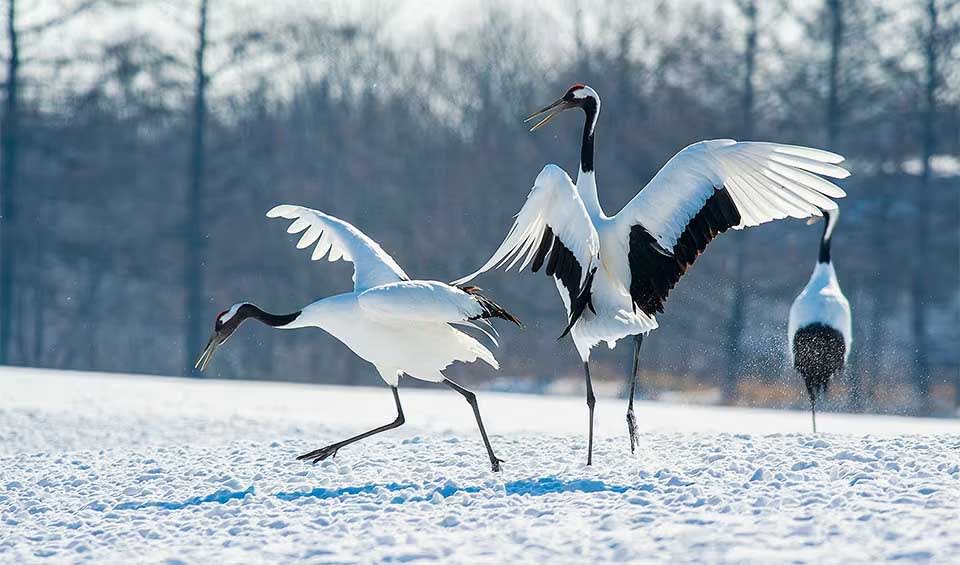China is known as one of the world’s mega-biodiverse countries, with a land area of about 9.6 million km² (3.7 million mi²), and more than 3 million km² (1.16 million mi²), of seawater under its jurisdiction. Its varied ecosystems support a wide range of species and habitats, spanning two bio-geographical realms and five climate zones.
China is a major crop origin center, almost 10,000 different crop species, including their wild relatives, have their origins in China. It also has 1,339 species and 528 genera of major cultivated plants, half of which are indigenous. China comes in second place worldwide in terms of total ecological footprint, despite having a smaller ecological footprint per person than the United States.
Fast economic growth, leading to the country’s status as the world’s largest economy by purchasing power parity (PPP) in 2022, has placed significant pressure on its natural environment. This has resulted in habitat degradation, an increase in endangered species, and challenges in biodiversity conservation efforts.
Four pillars elaborated:
China is undergoing significant changes due to rapid economic growth and urbanization, affecting the environment. But, great efforts are being made to balance things out. By 2008, China had set up 2,538 nature reserves, covering 15.13% of the country’s total land area—higher than the global average of 12%. Now, ~17% of China’s protected areas are moderately connected, with a score of 0.601854, many are continuous enough to allow wildlife movement (wildlife corridors). They’ve also protected 5.5% of their national waters. Land Management
Land Management
Urban, industrial, and agricultural uses have converted about 22.49% of the land. There are also some concerns, like a nitrogen index of 0.66, indicating soil pollution and high pesticide use.
On the bright side, China’s forest cover has jumped from 8.6% (in 1949) to an admirable 24.02%(by 2023). Although 90% of grasslands and 40% of wetlands are experiencing some degradation, the efforts to protect and rejuvenate the environment are making a positive impact. Overall, there’s a mix of challenges and successes.
China’s flora is incredibly diverse, with over 39,000 vascular plants, including more than 30,000 native species. There are six forest regions and numerous iconic animal species, like the beloved giant panda. About one-sixth of mammals and two-thirds of amphibian species in China are endemic (that you won’t find anywhere else!). Biodiversity Sensitivity
Biodiversity Sensitivity
China is a biodiversity goldmine, but there’s a catch: 22% of its animals and 11% of its higher plants are in danger of going extinct. On the IUCN Red List, 10.4% of terrestrial species and 17.2% of marine species are listed. Thankfully, protected areas cover 49.5% of terrestrial species and 59.7% of marine species. But, the populations of 48.6% of terrestrial and 69.3% of marine species are declining. Plus, 57.1% of fisheries in China’s Exclusive Economic Zone are depleted.
China has joined the international efforts to conserve biodiversity by ratifying the CBD and acceding to CITES, two major steps forward in the conservation of biodiversity. Robust policies, such as the China National Biodiversity Conservation Strategy and Action Plan (2011-2030), and the development of Ecological Conservation Red Lines (ECRLs), provide thorough conservation frameworks. Biodiversity monitoring networks like CERN and China BON support research and protection efforts. Financial aid and talent development boost conservation efforts. Capacity and Governance
Capacity and Governance
Indicators of China’s governance show challenges, including elevated rates of violence and instability as well as concerns about corruption and restricted democratic rights. The population growth rate remains stable, and the Human Development Index indicates moderate progress with 0.77 points.
China’s superficial efforts in biodiversity conservation may seem commendable, but their actions tell a different story. China’s insatiable demand for wildlife products drives a global poaching crisis and threatens precious endangered populations. They claim conservation leadership, yet they are the largest consumers of illegal wildlife products, ranging from ivory, rhino horns, sharks, frogs to any wildlife or its parts you can name. This demand supports extensive illegal trade networks, often controlled by international crime syndicates, facilitated by widespread corruption among Chinese officials. Global collaboration is essential to hold China accountable and ensure genuine conservation efforts.
China’s biodiversity conservation roadmap for 2030 aims to write a new chapter, by setting ambitious biodiversity conservation targets and indicating a fundamental shift in its approach to environmental protection. A delicate balance between in-situ and ex-situ conservation will be prioritized through the China National Biodiversity Conservation Strategy and Action Plan (2011-2030). Future Trends
Future Trends
This forward-looking strategy will encompass a range of actions, from policy improvements to the integration of biodiversity conservation into planning processes and the enhancement of conservation scopes. China will create a more resilient and dynamic ecological landscape by designating 35 priority areas for conservation. Proactively addressing new threats to biodiversity, encouraging public participation, and ensuring equitable benefit sharing will be key components of the planning strategy.
Yale’s recent EPI score of 28.4 suggests progress towards a greener future, but is it truly sustainable and justified when wildlife is considered mere resources under Chinese laws? This still remains an unanswered question for the future.
Biodiversity
China ranks among the world’s 12 mega-biodiverse countries, with forests covering 20.36% of its total land area and possibly holding the largest stock volume of forest plantations globally, supporting diverse wildlife. The nation is also recognized as one of the eight primary centers of crop origin, home to nearly 10,000 crop species and their wild relatives, including 528 genera and 1,339 species of major cultivated plants, half of which are indigenous to China.Additionally, China boasts extensive wetlands, including 13.7 million (137,000 km²) hectares of marshes, 8.35 million hectares (83,500 km²) of lakes, and 8.21 million hectares (82,100 km²) of river wetlands. Its grasslands, which constitute about 41.7% of the country, host 6,704 species of forage plants, 320 of which are unique to China. These natural grasslands also support over 2,000 species of wild animals and numerous economically and medicinally valuable plants like licorice and ephedra sinica stapf. China accounts for more than 10% of the world’s marine biodiversity in marine environments, with 20,278 recorded marine species.
In the table below are the number of known species in several main groups, how many of these species are Threatened with extinction, and how many of them are Endemic (unique to China only):
| Species (World rank) |
Threatened | % Threatened | Endemic | % Endemic | |
|---|---|---|---|---|---|
| Mammals | 722 (#4) | 73 | 10.1% | 202 | 28.0% |
| Birds | 1,288 (#8) | 94 | 7.3% | 66 | 5.1% |
| Reptiles | 644 (#8) | 43 | 6.7% | 118 | 18.3% |
| Amphibians | 613 (#5) | 87 | 14.2% | 458 | 74.7% |
| Fishes | 3,568 (#5) | 265 | 7.4% | 147 | 4.1% |
| Plants | 31,015 (#6) | 593 | 1.9% | 15,103 | 48.7% |
mammals
Sun bear
The smallest of bears is slowly vanishing from tropical forests of Southeast Asia
Red panda
Be ready to be puzzled by this vegetarian carnivore!
Golden snub-nosed monkey
A monkey with a golden coat and a nose that looks like it’s been squished flat
birds
Asian openbill
Adept hunters of freshwater snails and mollusks, using their specialized bills to extract their prey from their shells
Mandarin duck
Revered in many cultures for their beauty, grace, and symbolism of love and fidelity
Himalayan monal
It’s dazzling plumage has earned it the nickname “nine-colored bird” in some cultures
reptiles
Chinese alligator
One of the only two living alligator species is in a grave danger
Chinese water dragon
An arboreal lizard that calls the water’s edge its home
Yangtze giant softshell turtle
No other turtle is rarer than the Yangtze giant softshell turtle
amphibians
Common Chinese tree frog
Their skin can absorb water directly from the environment, which helps them stay hydrated in various conditions
Chinese giant salamander
A gargantuan beast, though harmless. Not many predators dare touch it —except for, of course, humans
Asiatic toad
The toxin from their parotoid glands has potential antimicrobial and anticancer medicinal properties
National Animals
Giant panda
The fading black and white bears of the bamboo forests
Red-crowned crane
A symbol of immortality and peace in many Asian cultures
Golden pheasant
One of the most colorful and striking birds in the avian world



















